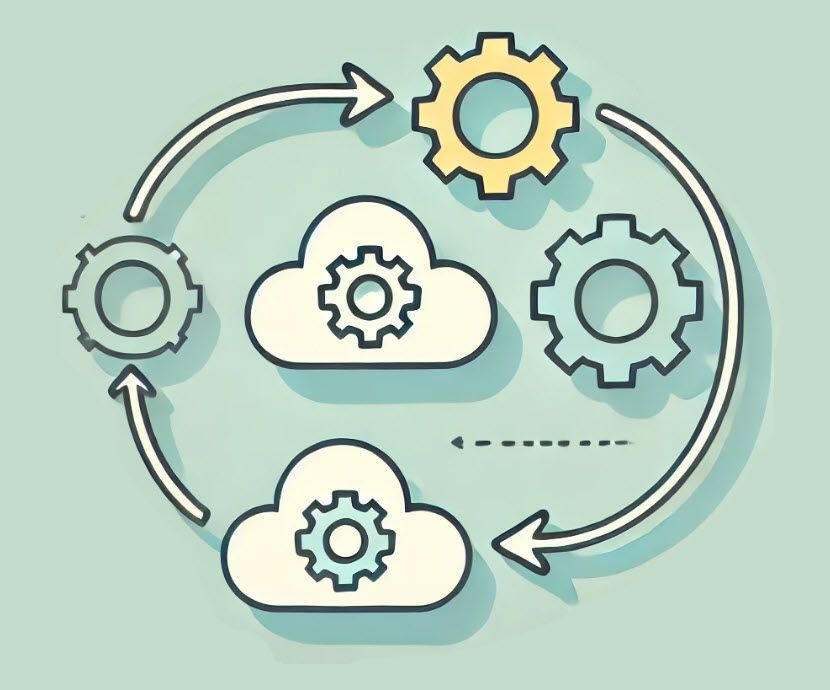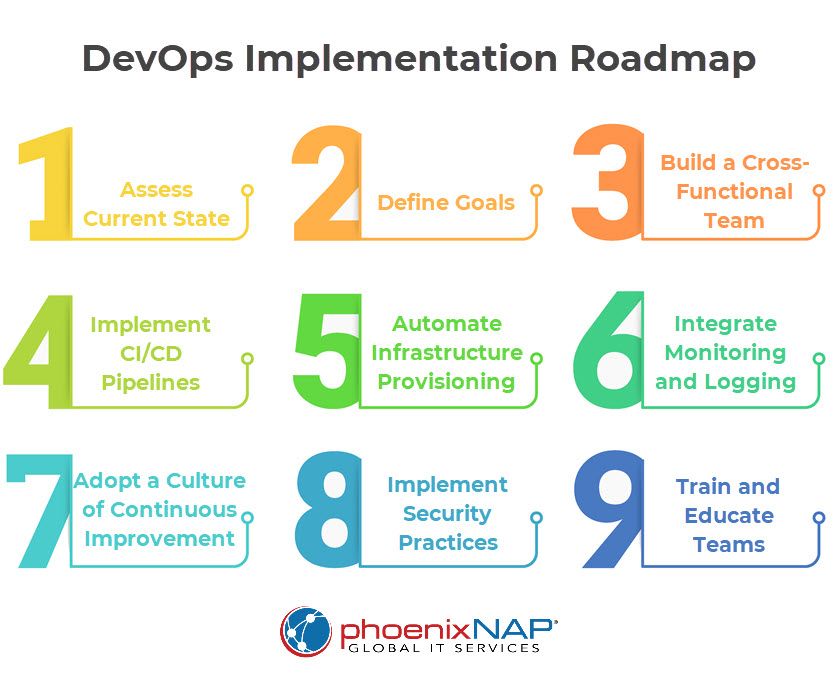Are you considering a shift to DevOps but are unsure where to start? Many organizations faced the same challenge but have successfully transitioned and are now reaping the benefits.
This article will guide you through the DevOps implementation process with a step-by-step strategy. We will cover everything from breaking down silos to automating workflows and promoting a culture of continuous improvement. Whether you're starting from scratch or refining your existing processes, this guide equips you with the knowledge and tools to successfully leverage DevOps.
Why Implement DevOps?
Implementing DevOps brings numerous benefits to an organization. Here are the main reasons organizations are adopting this approach:
- Improved collaboration and communication. DevOps encourages a culture of collaboration between development and operations teams. This culture leads to a more cohesive workflow and faster problem resolution.
- Enhanced quality and reliability. Continuous integration and continuous delivery (CI/CD) pipelines ensure that code is tested and validated before deployment. This practice reduces the likelihood of bugs and improves reliability.
- Increased deployment frequency. Organizations adopting DevOps practices increase their deployment frequency. This acceleration allows faster delivery of features, updates, and bug fixes.
- Better resource management. DevOps principles enable more efficient use of infrastructure and resources. Automated scaling and monitoring ensure that resources are allocated optimally, reducing waste and lowering costs.
- Improved efficiency and productivity. Automating repetitive tasks like testing and deployment frees time for developers and operations teams.
- Enhanced security. Integrating security practices into the DevOps workflow (DevSecOps) ensures that security is considered at every stage of the development process. This approach reduces vulnerabilities and improves the overall security posture.
- Faster time to market. Automated processes and streamlined workflows enable organizations to deliver products and updates faster.
Are you confused about the differences between continuous delivery, deployment, and integration? Read our article to learn more about these practices and see which one is right for your team.

DevOps Implementation Plan
Implementing DevOps involves the following key steps:
1. Assess Current State
Start by conducting a detailed assessment of your organization's development and operations processes. Engage key stakeholders and team members to identify pain points, bottlenecks, and areas for improvement. Next, evaluate workflows, communication channels, and existing tools to gain a clear understanding of current capabilities and limitations.
Here are the key areas to assess:
- Workflows. Map out the current workflows to identify inefficiencies and redundancies. Analyze how tasks move from development to operations and where delays occur.
- Tools and technologies. Assess the tools currently used for development, testing, deployment, and monitoring. Determine whether these tools meet the organization's needs or if there are better alternatives.
- Communication channels. Evaluate the effectiveness of communication between teams. Identify gaps in information sharing that may lead to misunderstandings or delays.
When your organization decides to retire some tools from your stack, check out our list of the best DevOps tools.
2. Define Goals
Define the goals you want DevOps implementation to achieve, such as reducing deployment times, increasing deployment frequency, or improving collaboration between teams. These goals should align with the organization's overall business objectives to ensure the DevOps transformation supports the broader strategy.
Here are some goals you should define:
- Reduction in deployment times. Set specific targets for how quickly you can move code from development to production.
- Improved collaboration. Establish goals for improving communication and cooperation between development and operations teams.
- Increased deployment frequency. Aim to increase the number of deployments within a given period, ensuring that updates and features reach users faster.
Key performance indicators (KPIs) are an effective way to measure goals. Read our article on DevOps metrics and KPIs to learn which metrics are worth tracking.
3. Build a Cross-Functional Team
Form a cross-functional team that includes members from development, operations, quality assurance, and cybersecurity. Ensure team members are committed to the DevOps transformation and have the necessary skills and expertise. Including staff with diverse roles ensures that different perspectives are considered, leading to more robust solutions.
Here are the teams that you should include:
- Development. Include software developers who understand the application architecture and can write efficient, maintainable code.
- Quality assurance. Incorporate QA engineers who can design and implement comprehensive testing strategies.
- Operations. Involve operations personnel who manage infrastructure, deployment processes, and system performance.
- Cybersecurity. Involve experts who will build security into the development process from the start.
Encourage open communication within this group. Establish regular meetings and use collaboration tools to facilitate information sharing and coordination. This multidisciplinary squad will drive your DevOps initiative, working together to break down silos and streamline the development and operations processes.
Read our article on the essential DevOps roles and responsibilities to learn who you need to hire and what to account for to create an efficient DevOps team.
4. Implement CI/CD Pipelines
Develop and implement CI/CD pipelines. Automate the process of building, testing, and deploying code to ensure that changes are integrated and delivered seamlessly.
Continuous integration automates the process of integrating code changes from multiple contributors into a shared repository several times a day. You can use tools like Jenkins to automate build and test processes. This procedure ensures that code changes are tested as soon as they are committed, reducing integration issues.
On the other hand, continuous delivery automates code deployment to production environments. This process includes staging, testing, and final deployment. By automating these steps, you ensure consistent and reliable deployments.
5. Automate Infrastructure Provisioning
Automate infrastructure provisioning and management using Infrastructure as Code (IaC) tools like Terraform or Ansible. IaC ensures that infrastructure configurations are consistent across different environments (development, test, production). Additionally, storing infrastructure code in version control systems like Git enables teams to track changes, collaborate, and roll back to previous configurations if needed.
With IaC, you can easily scale infrastructure up or down based on demand, which is crucial for handling varying workloads.
6. Integrate Monitoring and Logging
Implement monitoring and logging solutions to gain visibility into the performance and health of applications and infrastructure. These solutions enable you to create dashboards for monitoring key performance metrics, including CPU and memory usage, response times, and error rates.
Use tools like Prometheus and Grafana to monitor metrics, receive alerts, and create dashboards for real-time data visualization. The ELK Stack collects logs from various sources (applications, servers, network devices) and centralizes them for analysis, making it particularly well-suited for comprehensive log management.
7. Adopt a Culture of Continuous Improvement
Continuous improvement is a core principle of DevOps, driving teams to constantly seek better ways to work and deliver value. This mindset ensures the organization remains adaptable and responsive to change, continually optimizing workflows and practices.
Encourage continuous improvement by regularly reviewing and refining DevOps processes. Gather feedback from team members and stakeholders to identify areas for enhancement. Implement regular retrospectives to discuss successes, challenges, and opportunities for growth. Establish feedback loops with stakeholders, including product owners and end-users, to ensure that the development process aligns with user needs and business objectives.
8. Implement Security Practices
Incorporate security into the DevOps workflow to ensure that it is a core component of the development process.
Here are the key security practices to implement:
- Automated security testing. Implement automated security tests, such as static application security testing (SAST) and dynamic application security testing (DAST), into the CI/CD pipeline.
- Security checkpoints. Incorporate security checkpoints into the development process to verify that you meet security requirements at each stage.
- Regular security assessments. Conduct regular security assessments and audits to identify vulnerabilities and ensure compliance with security standards.
9. Train and Educate Teams
Education and training are vital for keeping teams up-to-date with DevOps trends and technologies. This investment in human capital is crucial for sustaining the DevOps culture and ensuring long-term success.
Ensure your team has the necessary knowledge and skills by implementing the following:
- Continuous learning. Provide access to resources such as books, online tutorials, and industry conferences to encourage continuous learning and professional development.
- Training programs. Develop and offer training programs on crucial DevOps concepts and tools. This may include workshops, online courses, and certification programs.

Are you interested in becoming a DevOps specialist? Check out our DevOps roadmap, which outlines everything you must know to be successful in a DevOps role.
DevOps Implementation: Best Practices
Below are the best practices for successful DevOps implementation.
Create a Pilot Team
Before transitioning the entire organization to DevOps, create a pilot team to test and refine your practices.
The pilot team should comprise highly skilled and motivated individuals who are open to experimenting with new methodologies and tools. They will serve as a model for other teams, identifying potential challenges and best practices.
Transition Other Teams to DevOps
Once the pilot team has successfully adopted DevOps and refined the processes, expand these practices to other teams within the organization. Gradually introducing the change reduces resistance and increases effectiveness.
Maintaining a flat organizational structure empowers teams by making them accountable for their successes and failures. This structure promotes ownership and responsibility, which are critical for a successful DevOps transition.
Promote Knowledge Sharing
To facilitate the DevOps transition, create 'Chapters' where individuals with similar skills collaborate within SCRUM teams to solve problems. These Chapters function as communities of practice, where members share knowledge and best practices and support each other in their DevOps journey.
Hosting regular knowledge-sharing events is an excellent way to spread DevOps practices across the organization. These events provide a platform for teams to highlight their successes, discuss challenges, and learn from each other's experiences.
You can ensure a smooth transition and widespread adoption by incrementally expanding the DevOps culture. Each team that successfully adopts DevOps becomes a model for others, creating a ripple effect that eventually transforms the entire organization. This gradual approach allows for adjustments and improvements along the way, ensuring the DevOps implementation is sustainable and effective in the long term.
Promote a Blameless Culture
Develop a culture where team members feel safe to share mistakes and learn from them. Encourage open communication, transparency, and collaboration to continuously improve processes and outcomes.
A blameless culture supports a learning environment where failures are viewed as opportunities for growth and improvement. It also supports innovation and risk-taking, which are essential for driving improvement and achieving long-term success.
Push the DevOps Culture Change
Implementing a DevOps culture change in an established organization is challenging but achievable. Treat the initiative as a startup within the company by creating small, agile team structures.
Challenge existing processes and tools to identify more efficient solutions. Secure executive support to drive the change and motivate the broader organization. Executive buy-in is crucial for overcoming resistance and ensuring the DevOps initiative has the resources and support to succeed.
Create Self-Sufficient Teams
DevOps thrives in cross-functional and self-sufficient teams with specialized roles. Consider transitioning from full-stack developers to DevOps software engineers and from SysAdmins to Site Reliability Engineers (SREs).
This approach builds teams capable of delivering projects independently. Assign specific roles: SREs for infrastructure coding, software engineers for application development, QA engineers for automation testing, and architects for solution design.
Promote cross-functional collaboration to enhance team capabilities. This will ensure the team can manage all aspects of the development lifecycle internally, reducing dependencies and bottlenecks.
Automate Everything
Strive to automate as many processes as possible, including testing, deployment, infrastructure provisioning, and monitoring. Automation reduces human error, increases efficiency, and allows you to focus on big-picture initiatives.
Additionally, by automating repetitive tasks, your team can streamline workflows and ensure consistency across the development lifecycle. Automation also enables faster feedback loops, allowing you to quickly identify and address issues and continuously improve processes.
Adopt a Microservices Architecture
Break down applications into smaller, independent services that can be developed, deployed, and scaled independently. Microservices architecture enhances agility, scalability, and fault tolerance, allowing teams to deploy changes more frequently and recover from failures quickly. Each microservice can be developed and deployed independently, enabling more flexible and modular development.
This architecture also facilitates the use of different technologies and languages best suited for each service, further enhancing efficiency and innovation.
Implement Continuous Testing
Integrate automated testing into the CI/CD pipeline to ensure that code is continuously reviewed for quality and functionality.
Validate code at different pipeline stages using unit, integration, and end-to-end tests. Continuous testing helps detect and resolve issues early, reducing the risk of defects in production.
Use Version Control for All Code
Store all code in a version control system, including application code, configuration files, and scripts. This practice ensures transparency and accountability, making tracking and managing changes easier. Version control systems also support branching and merging, allowing multiple team members to work on different features simultaneously without conflicts.
Test Your Progress
Regularly assess the progress of your DevOps implementation. Measure velocity and compare it with past projects to evaluate improvement. Ensure the team can adapt to feedback without requiring significant redesigns.
You should also monitor team morale. Positive engagement and interest from other teams indicate successful cultural adoption.

In-House vs. Outsourced DevOps Teams
Outsourcing DevOps enables organizations to implement DevOps without the need to build an in-house team. Outsourcing involves delegating various tasks and responsibilities related to infrastructure management, CI/CD pipelines, monitoring and logging, security, cloud management, and automation. By outsourcing these functions, organizations leverage the expertise of experienced professionals to achieve cost efficiency and focus on their core business.
Here are the factors to consider when deciding between in-house and outsourced:
- Control and customization. In-house teams offer greater control over processes and customization. Outsourced teams often follow standardized practices, which might not align perfectly with your requirements.
- Communication. Due to physical proximity and a shared working environment, in-house teams communicate better and respond faster. Outsourced teams might face challenges due to time zone differences and communication barriers.
- Cost. Outsourcing can be cost-effective for smaller companies or those with limited resources. However, in-house teams, although potentially more expensive up front, provide long-term benefits through deep integration with the company's culture and goals.
- Scalability. Outsourcing offers the flexibility to scale resources up or down according to project needs, eliminating the long-term commitment of hiring full-time staff. In-house teams might find it harder to scale quickly but offer more stability.
AIOps, short for artificial intelligence for IT Operations, is a framework that combines big data and machine learning to automate and enhance IT operations. It can identify patterns and anomalies human operators often miss and greatly improve your organization's efficiency.

Final Advice on DevOps Implementation
Persistence is vital to a successful DevOps transition. While the process is challenging, it is entirely achievable with support from the team, management, and executives. Furthermore, breaking down the process into manageable steps will allow you to tackle the challenges easily. However, be aware that commitment from all levels of the organization is crucial for overcoming obstacles and driving the cultural shift.



